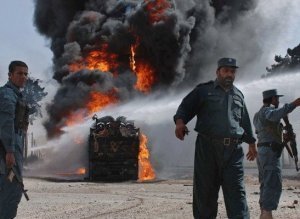 The Wall Street Journal:
The Wall Street Journal: Internal United Nations maps show a marked deterioration of the security situation in Afghanistan during this year's fighting season, countering the Obama administration's optimistic assessments of military progress since the surge of additional American forces began a year ago.
The Wall Street Journal was able to view two confidential "residual risk accessibility" maps, one compiled by the U.N. at the annual fighting season's start in March 2010 and another at its tail end in October. The maps, used by U.N. personnel to gauge the dangers of travel and running programs, divide the country's districts into four categories: very high risk, high risk, medium risk and low risk.
In the October map, just as in March's, nearly all of southern Afghanistan—the focus of the coalition's military offensives—remained painted the red of "very high risk," with no noted improvements. At the same time, the green belt of "low risk" districts in northern, central and western Afghanistan shriveled.
The U.N.'s October map upgraded to "high risk" 16 previously more secure districts in Badghis, Sar-e-Pul, Balkh, Parwan, Baghlan, Samangan, Faryab, Laghman and Takhar provinces; only two previously "high risk" districts, one in Kunduz and one in Herat province, received a safer rating.
Continue reading here.
No comments:
Post a Comment
Note: Only a member of this blog may post a comment.